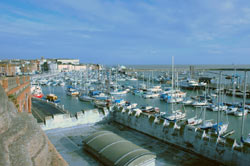Nikon 17-55mm f/2.8G ED DX
Once again showing their commitment to the DX format, Nikon have produced this professional quality standard zoom lens. It is not small and it is certainly not cheap, so what has it got going for it? We take a look.
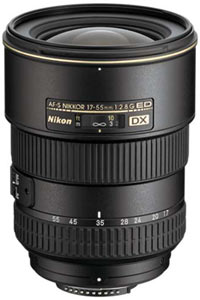 Specifications
Specifications
- Focal Length 17-55mm
- Max aperture f/2.8
- Min Aperture f/22
- Min focus distance 0.36m
- Construction 14 elements/10groups
- Filter size 77mm
- Weight 0.755kg
- Size 85.5x110.5mm
- Hood HB-31 (supplied)
- Mount Nikon
- Price (RRP)
Build and Handling
The lens is a conventional, two ring zoom with internal focussing operating manually or through a SWM AF system that is both quick and silent. The AF can be over-ridden manually without the need to turn off the Auto-function. Zooming does change the lens’ physical length with the front element extending by some 18mm at the wide end. The shortest overall length is achieved at around the 35mm mark before extending again by around 5mm at the 55mm long end.
With the large, HB-31 hood, which is supplied with the lens, in place, you do not even notice the extension. The zoom ring, which is closest to the body, could be a little wider on such a large lens but both that and the manual focus ring forward of it are well torqued and feel right. The zoom ring is marked at the 17, 20, 24, 28, 35, 45, and 55mm lengths and forward of the focus ring is a distance window marked in both metres and feet.
Being a G lens, there is no aperture ring and the only other control on the lens is the M/A-M switch, fitted on the left side of the barrel. The hood is a surprisingly deep petal shape that has a positive click-stop bayonet mount. The depth of the hood, however, will encroach on the flash coverage of any of Nikon’s on board flash units, giving a semi-circular shadow. It should also be noted that the lens is designed for the DX size sensor and will cause vignetting if used on 135 format film cameras.
Optical Quality
This lens is aimed at professional users and has an f/2.8 widest aperture throughout its focal range. Throughout this range, chromatic aberrations have been well controlled across the frame width. Resolution is good, especially ay the wide end of the zoom where it kicks in with very good figures. At the long end it is more conventional, needing a stop or so to get the best from it although it is still very usable.
The one disappointing place where the lens let itself down was in the distortion module of the Imatest software where the figures of 1.1% pincushion at the long end were acceptable but the 2.25% barrel shown at the wide end was beginning to become apparent. Although this is easily corrected in modern software, we have become used to much better figures on wide lenses of late.
Contrast and colour rendition, on the other hand, were both excellent and could not be faulted and the consistency of the results across the width of the frames is again, commendable.
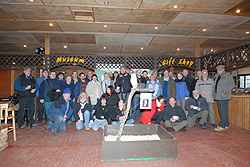 An exposure of 1/60sec at f/5 and ISO800 on Nikon D200 with the lens set at 17mm. The barrel effect at this setting is quite apparent in the ceiling, exposed using SB-800 flash. | 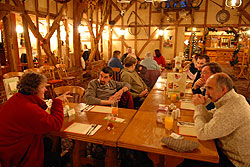 With settings of 1/6sec and f/2.8 using ISO800 and 17mm on the D200, this restaurant scene has retained all of the ambience that would have been lost using flash. |
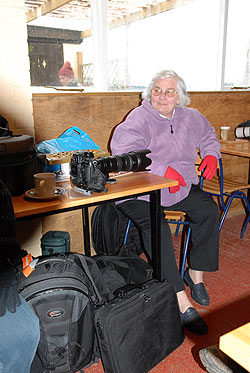 Set at 23mm and f/2.8, this shot shows good colour and contrast, but also shows the shadow thrown by the hood using on board flash. | 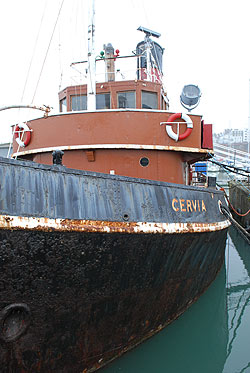 |
 |
Click on each comparision photo below to view full size versions
Below is our lens test data. To find out how to use these graphs look at this article: How we test lenses
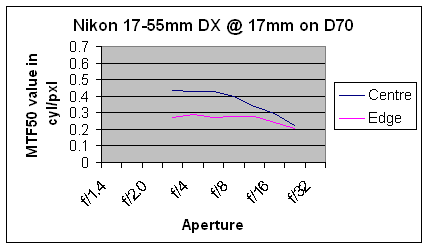
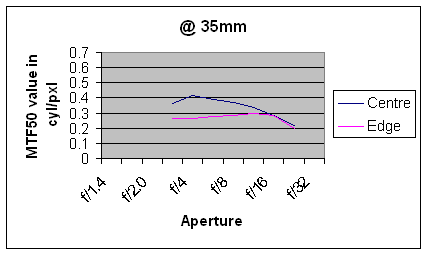
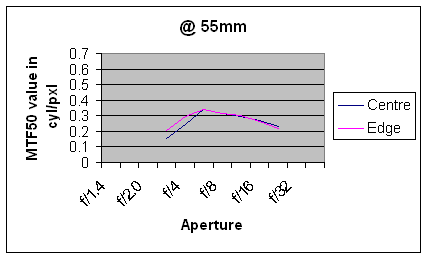
Verdict
Nikon recommend this lens for use as a standard on their top end cameras and with an approximate 30% improvement on performance over the 18-70mm f/3.5-4.5 we can see why. With lens quality fast becoming the limiting factor where top end digital imaging is concerned, 30% is a big step, but the improvement comes at a price. If you earn your living from your camera, then this lens is well worth considering but if not, and you don’t need the low light performance, the laws of diminishing returns may well come into play.
In summary, the positive points of the Nikon 17-55mm f/2.8G ED DX are:
![]() Excellent wide-open performance, especially at the wider focal length
Excellent wide-open performance, especially at the wider focal length
![]() Good build quality.
Good build quality.
![]() Excellent contrast and colour rendition.
Excellent contrast and colour rendition.
![]() Good hood included
Good hood included
The negative points are:
![]() Disappointing control of distortion at the wide end.
Disappointing control of distortion at the wide end.
![]() Price, although value for money is relative.
Price, although value for money is relative.
![]() Hood useless with on board flashes.
Hood useless with on board flashes.
Check the latest price of the Nikon 17-55mm f/2.8G ED DX here
Test by Ian Andrews
Add your message
Please login here or if you've not registered, you can register here. Registering is safe, quick and free.
photodo Stats
428 MTF tests
74 in-depth photodo reviews
100+ users join each day
Help the lens community by reviewing or rating a lens today via our lens search
Latest Lens Reviews
- Chinon 28mm f/2.8 Vintage Lens Review
- Canon EF 70-200mm f/4L IS II USM Lens Review
- Samyang AF 85mm f/1.4 EF Review
- Sigma 70mm f/2.8 DG Macro Art Review
- Samyang AF 24mm f/2.8 FE Review
- Meike 50mm f/1.7 Review
- Tamron 70-210mm f/4 Di VC USD Review
- Lensbaby Burnside 35mm f/2.8 Review
- Asahi Super Takumar 50mm f/1.4 Review
- Asahi Super-Multi-Coated Takumar 135mm f/3.5 Review

